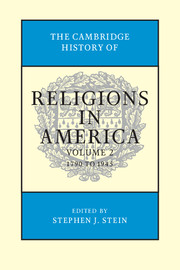Book contents
- Frontmatter
- Contents
- Contributors
- Editor's Introduction
- SECTION I RELIGION IN NORTH AMERICA
- SECTION II RELIGIONS IN THE NEW NATION, 1790–1865
- SECTION III CHANGING RELIGIOUS REALITIES
- 11 Diversity, Revival, Rivalry, and Reform: Protestant Christianity in the United States, 1800–1950
- 12 American Catholics, 1800–1950
- 13 American Judaism, 1820–1945
- 14 Formation and Consolidation of African American Religious Communities, 1865–1945
- 15 Eastern Orthodox Christianity in America
- 16 New Religious Movements
- 17 American Indian Religions in America, 1790–1945
- 18 Why Muslims Matter to American Religious History, 1730–1945
- 19 Asian Religions in the United States: The Role of the 1893 World’s Parliament of Religions in Shaping an Evolving Pluralist Ideology
- 20 Metaphysical Movements
- SECTION IV RELIGIOUS RESPONSES TO MODERN LIFE AND THOUGHT
- SECTION V COMPARATIVE ESSAYS
- SECTION VI RELIGION AND DIVERSE AREAS
- Index
- References
11 - Diversity, Revival, Rivalry, and Reform: Protestant Christianity in the United States, 1800–1950
from SECTION III - CHANGING RELIGIOUS REALITIES
Published online by Cambridge University Press: 28 July 2012
- Frontmatter
- Contents
- Contributors
- Editor's Introduction
- SECTION I RELIGION IN NORTH AMERICA
- SECTION II RELIGIONS IN THE NEW NATION, 1790–1865
- SECTION III CHANGING RELIGIOUS REALITIES
- 11 Diversity, Revival, Rivalry, and Reform: Protestant Christianity in the United States, 1800–1950
- 12 American Catholics, 1800–1950
- 13 American Judaism, 1820–1945
- 14 Formation and Consolidation of African American Religious Communities, 1865–1945
- 15 Eastern Orthodox Christianity in America
- 16 New Religious Movements
- 17 American Indian Religions in America, 1790–1945
- 18 Why Muslims Matter to American Religious History, 1730–1945
- 19 Asian Religions in the United States: The Role of the 1893 World’s Parliament of Religions in Shaping an Evolving Pluralist Ideology
- 20 Metaphysical Movements
- SECTION IV RELIGIOUS RESPONSES TO MODERN LIFE AND THOUGHT
- SECTION V COMPARATIVE ESSAYS
- SECTION VI RELIGION AND DIVERSE AREAS
- Index
- References
Summary
Statistics tell a story. The newly formed United States of America included roughly 300,000 Protestant Christians in the year 1800. Yet by the year 1950, this number had grown to 43 million. This is a 143-fold increase, or a growth of 14,300 percent. The figure becomes more striking when one considers that the population of the nation, according to the United States Census, increased during the same period by the order of 28.4 times, from 5.3 million to 150.7 million. The increase in Protestant Christian affiliation during this period was 5.0 times the rate of the general population increase. Roger Finke and Rodney Stark noted that “the most striking trend in the history of religion in America is growth.” The overall rate of religious adherence in the U.S. population steadily climbed from 17 percent in 1776, to 34 percent in 1850, 45 percent in 1890, 56 percent in 1926, 59 percent in 1952, and 62 percent in 1980.
One thing should be clear. It is a mistake to think that there was a Christian golden age in the United States during the colonial era, followed by a long gradual process of secularization and decline. Steadily increasing religious affiliation is the dominant pattern in the United States over the last two centuries. The period of lowest religious affiliation in American history occurred around 1800 when there were much lower levels of church membership than at the present.
- Type
- Chapter
- Information
- The Cambridge History of Religions in America , pp. 223 - 250Publisher: Cambridge University PressPrint publication year: 2000



